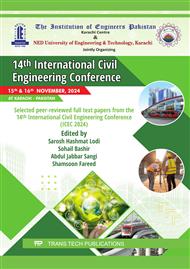p.181
p.191
p.205
p.213
p.223
p.233
p.241
p.249
p.255
Innovative Approaches to Liquefaction Mitigation in Seismic Zones: A Comprehensive Overview
Abstract:
Another vulnerability that arises due to soil conditions is the liquefaction of soil in seismic zones which is a major risk as this form of soil behaves like liquid when it experiences an earthquake leading to effects such as infrastructure and posing dangerous risks to the lives of people. The conventional mitigation measures including tampering of soil and provision of drainage system present certain disadvantages in as much as cost, eco-friendly nature, and efficiency are concerned. Newer development strategies for liquefaction mitigation are targeted at advanced techniques of ground improvement that include jet grouting, vibro-replacement, and deep soil mixing because they could provide the same kind of enhancement to the underforming soil layer while causing less interference with the environment. Further, the traditional methods such as microbial induced calcite precipitation (MICP) also provide better solutions which are eco-friendly, as they use the natural process for enhancing the strength of the soil. Modern technology in digital and sensors have also brought about smart monitoring systems which give information on the behavior of the soil and propensity towards liquefaction. As this review paper aims to focus on the emerging techniques in the liquefaction mitigation, the findings of this paper seek to compare the performance of the new methods and their feasibility in the seismic regions. Some of these innovations and their performance and value, along with economic, environmental, and engineering trade-offs, are illustrated with case studies from different regions. One of the key factors regarding these technologies is their interdisciplinary collaboration as the challenges of developing seismic-safe infrastructures and increasing seismic risks as a result of urban growth persist.
Info:
Periodical:
Pages:
255-262
Citation:
Online since:
April 2025
Authors:
Price:
Сopyright:
© 2025 Trans Tech Publications Ltd. All Rights Reserved
Share:
Citation:


